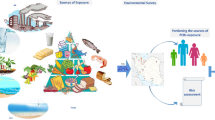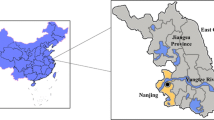Abstract
Bisphenol A (BPA) is an endocrine disruptor widely used in the production of polycarbonate plastics and epoxy resins. Exposures to BPA have been associated with reproductive, developmental, and cardiovascular effects. In this study, the CalTOX model was used to assess the aggregate health risks on BPA by integrating the currently available BPA data in various environmental media in Taiwan. Local parameters such as chemical properties, local landscape data, and exposure factors were used as model inputs under the continuous source mode. A reference dose (RfD) of 50 μg/kg-day was adopted in this assessment. Monte Carlo simulation was used to simulate great variability of the environmental data. Our results show that an upper limit of 95 % confidence interval of aggregate exposures for the adults (19–64 years old) was 1.05 μg/kg-day, corresponding to a hazard index (HI) of 0.021. The chemical properties (BPA half-life in surface water), intake rates (fruit, vegetable, and fluid intake), and landscape data (average depth of surface waters and leaf wet density) are critical parameters. Finally, HI value would approach to 1 as BPA concentrations in ambient air, surface water, and sediment was greater than 20 ng/m3, 100 μg/L, and 3.3 mg/kg. The quality of the risk assessment on BPA can be further improved by reduction of uncertainty of the abovementioned critical parameters as well as considering additional BPA exposures from canned and packaged goods.



Similar content being viewed by others
References
AFSSA, French Food Safety Agency (2010) Opinion of the French Food Safety Agency regarding exposure to bisphenol A in the French polulation and maximum levels of bisphenol A in foods. https://www.anses.fr/en/system/files/MCDA2010sa0041EN.pdf. Accessed 7 July 2015
Bailey AB, Hoekstra E (2011) Sources and occurrence of bisphenol A relevant for exposure of consumers. World Health Organization, Geneva
Bromer JG, Zhou YP, Taylor MB, Doherty L, Taylor HS (2010) Bisphenol-A exposure in utero leads to epigenetic alterations in the developmental programming of uterine estrogen response. Faseb J 24:2273–2280
Central Weather Bureau, Taiwan (2011) Snnual average precipitation and ambient environmental temperature. http://opendata.cwb.gov.tw/index. Accessed 25 June 2015
Chapin RE, Adams J, Boekelheide K et al (2008) NTP-CERHR Expert panel report on the reproductive and developmental toxicity of bisphenol A. Birth Defects Res B Dev Reprod Toxicol 83:157–395
Chen PC (2004) Study of MFA and risk assessment for chromium in Taiwan. Dissertation, National Taiwan University, Taiwan
Chen TC, Shue MF, Yeh YL, Hsieh CY, Kuo YT, Kuo CT (2009) Variation, correlation, and toxicity of phenolic endocrine-disrupting compounds in surface water. J Environ Sci Health A Tox Hazard Subst Environ Eng 44:1244–1250
Chen TC, Shue MF, Yeh YL, Kao TJ (2010) Bisphenol A occurred in Kao-Pin River and its tributaries in Taiwan. Environ Monit Assess 161:135–145
Chiang LY (2011) The occurrence of Bisphenol A and Nonylphenol of water, sediment, fish in principal river environment and assessment of theirs release sources in Taiwan. Dissertation, National Cheng Kung University, Tainan
Chou WC, Chen JL, Lin CF, Chen YC, Shih FC, Chuang CY (2011) Biomonitoring of bisphenol A concentrations in maternal and umbilical cord blood in regard to birth outcomes and adipokine expression: a birth cohort study in Taiwan. Environ Health 10:94
CHRAP, Center for Health Risk Assessment and Policy (2008) Compilation of exposure factors. National Taiwan University, Taipei
Consumer testing technology (2012) Taiwan plans to ban bisphenol A in thermal paper. http://www.cttlab.com/en/news_show.php?serial=421. Accessed 12 August 2014
Della Seta D, Minder I, Belloni V, Aloisi AM, Dessi-Fulgheri F, Farabollini F (2006) Pubertal exposure to estrogenic chemicals affects behavior in juvenile and adult male rats. Horm Behav 50:301–307
Ding WH, Wu CY (2000) Determination of estrogenic nonylphenol and bisphenol A in river water by solid-phase extraction and gas chromatography-mass spectrometry. J Chin Chem Soc 47:1155–1160
Dolinoy DC, Huang D, Jirtle RL (2007) Maternal nutrient supplementation counteracts bisphenol A-induced DNA hypomethylation in early development. Proc Natl Acad Sci U S A 104:13056–13061
Durando M, Kass L, Piva J, Sonnenschein C, Soto AM, Luque EH, Munoz-de-Toro M (2007) Prenatal bisphenol A exposure induces preneoplastic lesions in the mammary gland in Wistar rats. Environ Health Perspect 115:80–86
EFSA (2008) Toxicokinetics of bisphenol A-scientific opinion of the panel on food additives, flavourings, processing aids and materials in contact with food (AFC). EFSA J 759:1–10
EFSA (2011) Statement on the ANSES reports on bisphenol A. EFSA J 9:2475
Fu P, Kawamura K (2010) Ubiquity of bisphenol A in the atmosphere. Environ Pollut 158:3138–3143
Gaido KW, Leonard LS, Lovell S, Gould JC, Babai D, Portier CJ, McDonnell DP (1997) Evaluation of chemicals with endocrine modulating activity in a yeast-based steroid hormone receptor gene transcription assay. Toxicol Appl Pharm 43:205–212
Glorennec P, Zmirou D, Bard D (2005) Public health benefits of compliance with current E.U. emissions standards for municipal waste incinerators: a health risk assessment with the CalTox multimedia exposure model. Environ Int 31:693–701
Grand view research (2014) Global bisphenol A (BPA) market by application (appliances, automotive, consumer, construction, electrical & electronics) expected to reach USD 20.03 billion by 2020: Grand view research, Inc.http://www.grandviewresearch.com/press-release/global-bisphenol-a-bpa-market. Accessed 30 June 2014
Hengstler JG, Foth H, Gebel T, Kramer PJ, Lilienblum W, Schweinfurth H, Volkel W, Wollin KM, Gundert-Remy U (2011) Critical evaluation of key evidence on the human health hazards of exposure to bisphenol A. Crit Rev Toxicol 41:263–291
Ho SM, Tang WY, Belmonte de Frausto J, Prins GS (2006) Developmental exposure to estradiol and bisphenol A increases susceptibility to prostate carcinogenesis and epigenetically regulates phosphodiesterase type 4 variant 4. Cancer Res 66:5624–5632
Hu CY (2010) Using MODIS image data to estimate the terrestrial primary production of Taiwan. Dissertation, National Pingtung University of Science and Technology, Taiwan
Huang YQ, Wong CKC, Zheng JS, Bouwman H, Barra R, Wahlstrom B, Neretin L, Wong MH (2012) Bisphenol A (BPA) in China: a review of sources, environmental levels, and potential human health impacts. Environ Int 42:91–99
Jiao FR, Sun XJ, Pang ZT (2008) Production and market analysis of Bisphenol A. Chem Ind 26:21–33
KEMI (2012) Proposal for a Swedish ban on bisphenol A in receipts. Swiss Chemical Agency.http://www.kemi.se/en/Content/News/Proposal-for-a-Swedish-ban-on-bisphenol-A-in-receipts/. Accessed 12 Aug 2014
Kuiper GG, Lemmen JG, Carlsson B, Corton JC, Safe SH, van der Saag PT, van der Burg B, Gustafsson JA (1998) Interaction of estrogenic chemicals and phytoestrogens with estrogen receptor β. Endocrinology 139:4252–4263
Lang IA, Galloway TS, Scarlett A, Henley WE, Depledge M, Wallace RB, Melzer D (2008) Association of urinary bisphenol A concentration with medical disorders and laboratory abnormalities in adults. JAMA 300:1303–1310
Lee HB, Peart TE (2000) Bisphenol A contamination in Canadian municipal and industrial wastewater and sludge samples. Water Qual Res J Canada 35:283–298
Lim DS, Kwack SJ, Kim KB, Kim HS, Lee BM (2009) Risk assessment of bisphenol A migrated from canned foods in Korea. J Toxicol Environ Health A 72:1327–1335
Lin PH (2001) Study on the estrogenic active substances in the environment. Study report (EPA-90-E3S5-02-01) submitted to the Taiwan Environmental Protection Administration, Taipei
Ma HW, Hung ML, Chen PC (2007) A systemic health risk assessment for the chromium cycle in Taiwan. Environ Int 33:206–218
Melzer D, Rice NE, Lewis C, Henley WE, Galloway TS (2011) Association of urinary Bisphenol A concentration with heart disease: evidence from NHANES 2003/06. PLoS One 5:e8673. doi:10.1371/journal.pone.0008673
Mendum T, Stoler E, VanBenschoten H, Warner JC (2011) Concentration of bisphenol A in thermal paper. Green Chem Lett Rev 4:81–86
Miyamoto K, Kotake M (2006) Estimation of daily bisphenol a intake of Japanese individuals with emphasis on uncertainty and variability. Environ Sci 13:15–29
National Statistics, Taiwan (2014) Taiwan landscape area.http://statdb.dgbas.gov.tw/pxweb/dialog/statfile9.asp. Accessed 25 June 2015
NTP (1982) Carcinogenesis bioassay of bisphenol A (CAS No. 80-05-7) in F344 rats and B6C3F1 mice (feed study). Natl Toxicol Program Tech Rep Ser 215:1–116
Reuss R, Leblanc JC (2011) Background paper on bisphenol A exposure assessment. World Health Organization, Geneva
Ryan BC, Vandenbergh JG (2006) Developmental exposure to environmental estrogens alters anxiety and spatial memory in female mice. Horm Behav 50:85–93
Sabatini L, Barbieri A, Violante FS (2005) Development and validation of a capillary high-performance liquid chromatography/electrospray tandem mass spectrometric method for the quantification of bisphenol A in air samples. Rapid Commun Mass Spectrom 19:3468–3472
Shelby MD (2008) NTP-CERHR monograph on the potential human reproductive and developmental effects of bisphenol A. NTP CERHR v, vii–ix, 1–64 (passim)
Shin BS, Hwang SW, Bulitta JB, Lee JB, Yang SD, Park JS, Kwon MC, Kim DJ, Yoon HS, Yoo SD (2010) Assessment of bisphenol A exposure in Korean pregnant women by physiologically based pharmacokinetic modeling. J Toxicol Environ Health A 73:1586–1598
Taiwan Environmental Protection Administration (EPA) (2009) Bisphenol A added to list of toxic chemicals; new restrictions on mercury, asbestos, and dioxane. http://www.epa.gov.tw/en/NewsContent.aspx?NewsID=1417&path=426. Accessed 12 Aug 2014
Thomson BM, Cressey PJ, Shaw IC (2003) Dietary exposure to xenoestrogens in New Zealand. J Environ Monit 5:229–235
Tian YH, Baek JH, Lee SY, Jang CG (2010) Prenatal and postnatal exposure to bisphenol A induces anxiolytic behaviors and cognitive deficits in mice. Synapse 64:432–439
Tien CJ (2009) The survey on the environmental distribution of toxic substances from 2009 to 2010 Environmental Protection Administration, Taiwan. http://epq.epa.gov.tw/Default.aspx. Accessed 110 Oct 2014
Tien CJ (2010) The survey on the environmental distribution of toxic substances from 2009 to 2010. Environmental Protection Administration, Taiwan. http://epq.epa.gov.tw/EPQ_ResultDetail.aspx?proj_id=ZHYFXVDLJN&recno=&document_id=8732#tab4. Accessed 10 Oct 2014
Tien CJ (2012) The environmental survey of toxic chemicals in Taiwan., 2011–2012. Environmental Protection Administration, Taiwan. http://epq.epa.gov.tw/Default.aspx. Accessed 10 Oct 2014
Tsai WT (2006) Human health risk on environmental exposure to Bisphenol-A: a review. J Environ Sci Health C 24:225–255
Tyl RW, Myers CB, Marr MC, Thomas BF, Keimowitz AR, Brine DR, Veselica MM, Fail PA, Chang TY, Seely JC, Joiner RL, Butala JH, Dimond SS, Cagen SZ, Shiotsuka RN, Stropp GD, Waechter JM (2002) Three-generation reproductive toxicity study of dietary bisphenol A in CD Sprague-Dawley rats. Toxicol Sci 68:121–146
Tyl RW, Myers CB, Marr MC, Sloan CS, Castillo NP, Veselica MM, Seely JC, Dimond SS, Van Miller JP, Shiotsuka RN, Beyer D, Hentges SG, Waechter JM Jr (2008) Two-generation reproductive toxicity study of dietary bisphenol A in CD-1 (Swiss) mice. Toxicol Sci 104:362–384
USFDA, U.S. Food Drug Administration (2009) Memorandum: exposure to Bisphenol A (BPA) for infants, toddlers and adults from the consumption of infant formula, toddler food and adult (canned) food. Department of Health and Human Services. https://www.federalregister.gov/articles/2010/04/05/2010-7511/food-additives-bisphenol-a-availability. Accessed 7 July 2015
Wetherill YB, Akingbemi BT, Kanno J, McLachlan JA, Nadal A, Sonnenscheing C, Watson CS, Zoeller RT, Belcher SM (2007) In vitro molecular mechanisms of bisphenol A action. Reprod Toxicol 24:178–198
Willhite CC, Ball GL, McLellan CJ (2008) Derivation of a bisphenol A oral reference dose (RfD) and drinking-water equivalent concentration. J Toxicol Environ Health B Crit Rev 11:69–146
Wilson NK, Chuang JC, Morgan MK, Lordo RA, Sheldon LS (2007) An observational study of the potential exposures of preschool children to pentachlorophenol, bisphenol-A, and nonylphenol at home and daycare. Environ Res 103:9–20
Wu HC, Yang WD (2012) Characteristics of bisphenol A exposure and the relevance ability of bisphenol A migration for the workers in polycarbonate molding factory. IOSH report
Author information
Authors and Affiliations
Corresponding author
Rights and permissions
About this article
Cite this article
Hsiao, IL., Wu, C., Huang, YJ. et al. Probabilistic assessment of aggregate risk for bisphenol A by integrating the currently available environmental data. Stoch Environ Res Risk Assess 30, 1851–1861 (2016). https://doi.org/10.1007/s00477-015-1122-5
Published:
Issue Date:
DOI: https://doi.org/10.1007/s00477-015-1122-5




